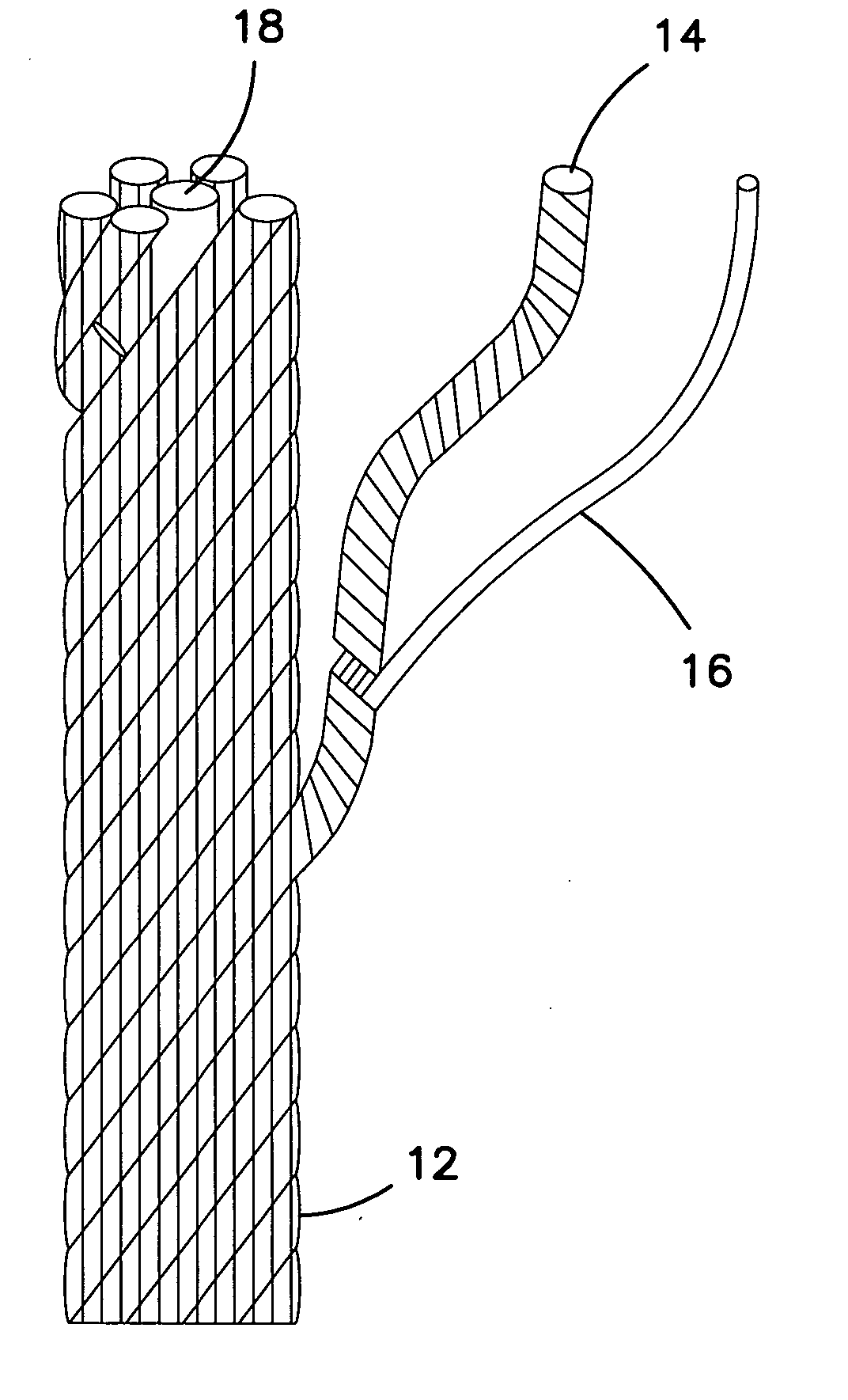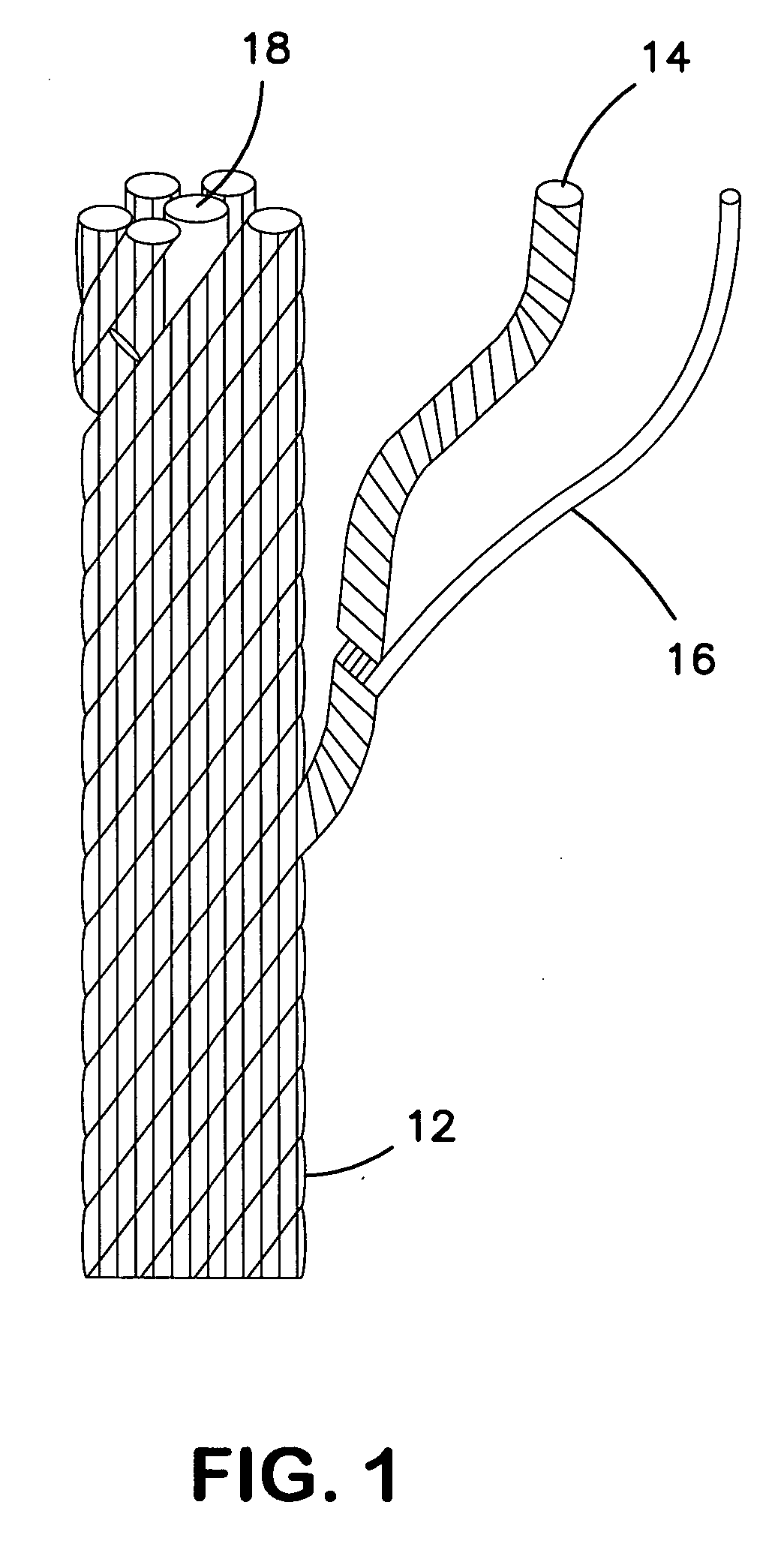Wire rope incorporating fluoropolymer fiber
a fluoropolymer fiber and wire rope technology, applied in the field of wire ropes, can solve the problems of abrasion and bending fatigue of wire ropes, lubricants, breakage, and need costly and time-consuming replacement, and achieve the effect of increasing the durability of wire ropes
- Summary
- Abstract
- Description
- Claims
- Application Information
AI Technical Summary
Benefits of technology
Problems solved by technology
Method used
Image
Examples
example 1
[0052] (a) Expanded PTFE monofilament fiber (part # V112447, W. L. Gore & Associates, Elkton Md.) was obtained. Properties of this fiber are presented in Table 1. The ePTFE fiber was combined with a single steel wire possessing a diameter of 0.32 mm, a mass per unit length of 5840 denier, and a break strength of 9.1 kg (Zinc Phos Braiding Wire 35, Techstrand, Lansing, Ill.). One of the fibers was combined with one of the wires. Fiber weight percent was determined. The two materials were twisted together and tested in accordance with the afore-mentioned abrasion test method. The test results appear in Table 2.
[0053] (b) Example 1(a) was repeated except two fibers were combined with one of the wires. Test results appear in Table 2.
[0054] (c) Example 1(a) was repeated except four fibers were combined with one of the wires. Test results appear in Table 2.
[0055] (d) Example 1(a) was repeated except six fibers were combined with one of the wires. Test results appear in Table 2.
[0056] ...
example 2
[0057] Expanded PTFE monofilament fiber was obtained that possessed the following properties: weight per unit length of 769 denier, tenacity of 2.4 g / d, and diameter of 0.29 mm. Properties of this fiber are presented in Table 1. The ePTFE fiber was combined a single steel wire possessing a diameter of 0.32 mm, a mass per unit length of 5840 denier, and a break strength of 9.1 kg (Zinc Phos Braiding Wire 35, Techstrand, Lansing, Ill.). The two materials were twisted together and tested in accordance with the afore-mentioned abrasion test method. The test results appear in Table 2.
example 3
[0058] (a) Expanded PTFE monofilament fiber (part # V111617, W. L. Gore & Associates, Elkton Md.) was obtained. Properties of this fiber are presented in Table 1. The ePTFE fiber was combined with a single steel wire possessing a diameter of 0.32 mm, a mass per unit length of 5840 denier, and a break strength of 9.1 kg (Zinc Phos Braiding Wire 35, Techstrand, Lansing, Ill.). One of the fibers was combined with one of the wires. Fiber weight percent was determined. The two materials were twisted together and tested in accordance with the afore-mentioned abrasion test method. The test results appear in Table 2.
[0059] (b) Example 3(a) was repeated except two fibers were combined with one of the wires. Test results appear in Table 2.
[0060] (c) Example 3(a) was repeated except four fibers were combined with one of the wires. Test results appear in Table 2.
[0061] (d) Example 3(a) was repeated except six fibers were combined with one of the wires. Test results appear in Table 2.
PUM
| Property | Measurement | Unit |
|---|---|---|
| weight % | aaaaa | aaaaa |
| weight % | aaaaa | aaaaa |
| weight % | aaaaa | aaaaa |
Abstract
Description
Claims
Application Information
 Login to View More
Login to View More - R&D
- Intellectual Property
- Life Sciences
- Materials
- Tech Scout
- Unparalleled Data Quality
- Higher Quality Content
- 60% Fewer Hallucinations
Browse by: Latest US Patents, China's latest patents, Technical Efficacy Thesaurus, Application Domain, Technology Topic, Popular Technical Reports.
© 2025 PatSnap. All rights reserved.Legal|Privacy policy|Modern Slavery Act Transparency Statement|Sitemap|About US| Contact US: help@patsnap.com



